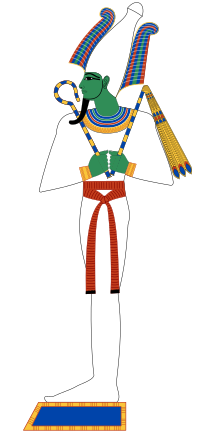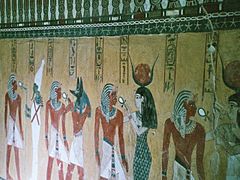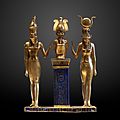Osiris facts for kids
In Egyptian mythology, Osiris is the god of life, death, the flooding of the Nile, and the afterlife. He was the brother and husband of Isis. They had a son named Horus. Osiris was murdered by his brother Set because Osiris was the pharaoh, which Set wanted to be. Osiris was killed when Set tricked him into getting into a box, then poured lead onto the box to close it so Osiris could not get out of it. However, Isis brought Osiris back to life for one night. After Horus was old enough, he defeated Set and became the pharaoh. Osiris' mother was the goddess Nut, father Geb, sister Nephthys, and sister as well as wife Isis.
Osiris and Dionysus
By the Hellenic era, Greek awareness of Osiris had grown, and attempts had been made to merge Greek philosophy, such as Platonism, and the cult of Osiris (especially the myth of his resurrection), resulting in a new mystery religion. Gradually, this became more popular, and was exported to other parts of the Greek sphere of influence. However, these mystery religions valued the change in wisdom, personality, and knowledge of truth, rather than the exact details of the accepted myths on which their teachings were overlayed. Thus in each region that it was exported to, the myth was changed to be about a similar local god, resulting in a series of gods, who had originally been quite distinct, but who were now synonymous with Osiris. These gods became known as Osiris-Dionysus.
Why Egypt loved Osiris
Egyptian civilization loved Osiris because he was a wise and gentle king. He taught them law and order and led them away from savage practices like human sacrifice. Osiris also taught them the art of agriculture and the appropriate rites for worshipping the gods. When he was done civilizing the people in Egypt, he left the country to his wife Isis and made peace in many other places. When he finished his job he then returned to Egypt.
Purpose
Osiris was the god of the Underworld. He was also one of the Nine Gods. One of his duties as Lord of the Dead was to do the very last judgment of the Dead, and after that to protect people from the dangers of the Underworld. The transition between life and death must have been a great experience, but still perilous .
Appearance
Osiris was shown in the form of a mummified pharaoh. He wore a white atef crown with feathers on the side, and held a crook and flail; tools of a pharaoh. Osiris had green skin, symbolizing rebirth to the Egyptians.
-
Head of the God Osiris, ca. 595–525 B.C.E. Brooklyn Museum
-
The family of Osiris. Osiris on a lapis lazuli pillar in the middle, flanked by Horus on the left and Isis on the right (Twenty-second Dynasty, Louvre, Paris)
-
A rare sample of Egyptian terra cotta sculpture which may depict Isis mourning Osiris. The sculpture portrays a woman raising her right arm over her head, a typical gesture of mourning. Musée du Louvre, Paris.
-
Judgment scene from the Book of the Dead. In the three scenes from the Book of the Dead (version from ~1375 BC) the dead man (Hunefer) is taken into the judgement hall by the jackal-headed Anubis. The next scene is the weighing of his heart against the feather of Ma'at, with Ammut waiting the result, and Thoth recording. Next, the triumphant Hunefer, having passed the test, is presented by the falcon-headed Horus to Osiris, seated in his shrine with Isis and Nephthys. (British Museum)
See also
 In Spanish: Osiris para niños
In Spanish: Osiris para niños













